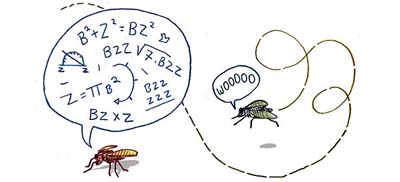Animals learn but smarter are not necessarily better (Part 1)
'Why are people so smart?' - this is a question that always appeals to scientists and evolutionary biologist Tadeusz Kawecki of the University of Friborg.
Dr. Kawecki wondered: 'Why are there such benefits to intelligence that most animals are silly?'
He and other scientists with the same thinking are trying to understand the cause of learning animals and why some species learn faster than others. Their research has found an interesting difference: intelligence is not good for animal health.
Learning is quite common in the animal world. Even the ultra-small vinegar Caenorhabditis elegans learns even though there are only 302 neurons. It eats bacteria but if it eats the pathogen, it will be infected. This worm has no 'aversion' to dangerous bacteria. They need time to learn to distinguish dangerous bacteria from other bacteria to avoid getting sick.

(Photo: Leif Parsons)
Many insects are quite intelligent. Biologist Reuven Dukas of McMaster University said: 'People treat insects as small robots that only act instinctively'. Research conducted by Dr. Dukas with others has proven that small insects deserve more importance than that.
He found the larvae of the common insect in the laboratory of all time, the Drosophila melanogaster fruit fly, which could learn to get used to certain food odors and smells related to enemies. In a series of other experiments, he found that male fruit flies wasted a lot of time flirting with indifferent females. It takes a lot of time for them to learn the cues of the fly that are easy to accept.
Dr. Dukas hypothesizes that any animal with a nervous system can learn . Even in cases where scientists do not have any evidence of learning in some species, he still thinks that finding a rule is not so fast. 'Is it because I'm not a good teacher or because animals don't learn?' , he asked the question.
Although studying very popularly in the animal world, Dr. Dukas wonders if it is appropriate to learn first. He said: 'We cannot just say that learning is an adaptive environment.'
Animals can still adapt to changing environments without resorting to nervous system to learn. Bacteria can change activities to survive. If a bacterium senses a toxin, it will avoid it. If it senses a new food source, it will control gene activity to regulate metabolism. According to Dr. Dukas, 'the genetic network of E. coli bacteria is surprisingly good in changing environmental conditions'.
Learning turns out to have harmful side effects that make the living environment more complex . Dr. Kawecki and colleagues recently found impressive evidence for these side effects by studying fruit flies as they evolved into more excellent 'students' in the lab.
To get smarter flies, researchers gave them a choice between orange and pineapple jelly for meals. Both items are attractive to them. But fruit flies perched on orange jelly found it to be mixed with bitter medicine for malaria. They took 3 hours to learn one thing that the attractive aroma of oranges followed was a scary taste.
To test these flies, the scientists then gave them two jelly plates, one orange and one pineapple. This time no plate contained bitter medicine. The flies land on both agar plates and enjoy and the females even lay eggs on them.
Dr. Kawecki said: 'Flies that have experienced a terrifying experience with a piece of orange jelly containing bitter medicine should have continued to avoid the orange plates and turned to pineapple jelly'.
He and his colleagues took eggs from pineapple jelly plates without bitter medicine, and from these eggs produced the next generation of fruit flies. They repeated the process in the new fruit fly generation, except for one thing, the pineapple agar plate was mixed with bitter medicine, not the orange jelly.
It only takes 15 generations as long as it does not change the gene programmed fruit flies for better learning. At the beginning of the experiment, the flies took hours to learn the difference between jelly with and without bitter medicine. The flies learn fast, it takes less than an hour.
But smart flies also pay a price. Dr. Kawecki and his colleagues brought their larvae mixed with individuals of another fly, then provided them with poor sources of yeast as food to see which ones survived. They performed similar experiments with ordinary relatives of intelligent flies that lived in other fly populations. About half of the smart flies exist while this figure in the normal fly with them is 80%.
-- Part 2 --
- Animals also learn but smarter are not necessarily better (Part 2)
- Tips to help you become smarter in the eyes of others
- Animals with strong claws smash ice and stink 4 times as skunks
- LEARN ABOUT ORIGINAL CELL (Part 1)
- Ha Long Bay - Land wonders set in the sky
- Earth warming makes lizards smarter
- Migratory birds learn
- Toddlers are smarter than primates
- The hot 'lip lock' of animals (Part 2)
- Breast cancer is not necessarily cancer
- Frogs have the ability to learn words in eggs
- Smart 'other development' human brain
 'Fine laughs' - Scary and painful torture in ancient times
'Fine laughs' - Scary and painful torture in ancient times The sequence of numbers 142857 of the Egyptian pyramids is known as the strangest number in the world - Why?
The sequence of numbers 142857 of the Egyptian pyramids is known as the strangest number in the world - Why? History of the iron
History of the iron What is alum?
What is alum?